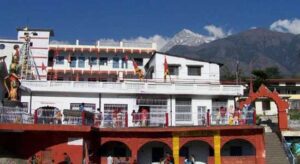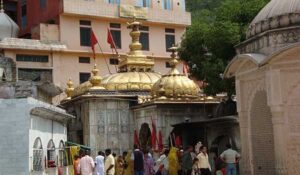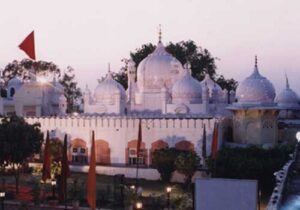Golden Temple is also known as Darbar Sahib and Hamrrinder Sahib. Golden temple is a prominent Sikh Gurdwara located in the city of Amritsar, Punjab, India. It was 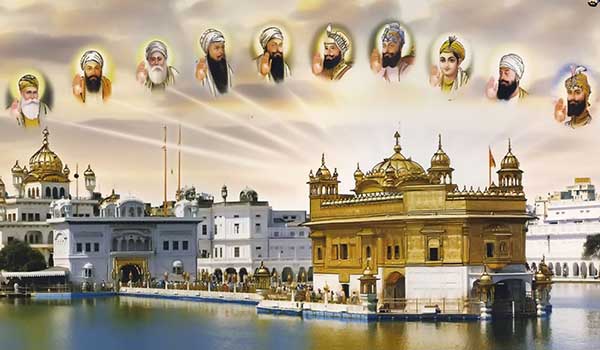 built by the fifth Sikh guru, Guru Arjan Dev, in the 16th Century. In 1604, Guru Arjan Dev completed the Adi Granth, the holy scripture of Sikhism, and installed it in the Gurdwara. There are four doors to get into the Golden Temple (Darbar Sahib), which symbolize the openness of the Sikhs towards all people and religions.The present day Gurdwara was rebuilt in 1764 by Jassa Singh Ahluwalia with the help of other Sikh Misl’s. In the early nineteenth century, Maharaja Ranjit Singh secured the Punjab region from outside attack and covered the upper floors of the Gurdwara with gold, which gives it its distinctive appearance and English name the Golden Temple.
built by the fifth Sikh guru, Guru Arjan Dev, in the 16th Century. In 1604, Guru Arjan Dev completed the Adi Granth, the holy scripture of Sikhism, and installed it in the Gurdwara. There are four doors to get into the Golden Temple (Darbar Sahib), which symbolize the openness of the Sikhs towards all people and religions.The present day Gurdwara was rebuilt in 1764 by Jassa Singh Ahluwalia with the help of other Sikh Misl’s. In the early nineteenth century, Maharaja Ranjit Singh secured the Punjab region from outside attack and covered the upper floors of the Gurdwara with gold, which gives it its distinctive appearance and English name the Golden Temple.
Golden Temple is considered holy by Sikhs as well as hindus. The most holy text of Sikhism, the Guru Granth Sahib, is always present inside the Gurdwara. Its construction was mainly intended to build a place of worship for men and women from all walks of life and all religions to come and worship God equally. Over one lakh people visit the holy shrine daily for worship.
Golden Temple (Darbar Sahib) literally means The Temple of God. The fourth guru of Sikhism, Guru Ram Das ji, excavated a tank in 1577 CE which subsequently became known as Amritsar (meaning “Pool of the Nectar of Immortality”), giving its name to the city that grew around it. In due course, a Sikh edifice, Golden Temple (meaning “the abode of God”), rose in the middle of this tank and became the supreme centre of Sikhism. Its sanctum came to house the Adi Granth comprising compositions of Sikh Gurus and other saints considered to have Sikh values and philosophies, e.g., Baba Farid, and Kabir. The compilation of The Adi Granth was started by the fifth guru of Sikhism, Guru Arjan Dev ji.
Originally built in 1574, the site of the Gurdwara was surrounded by a small lake in a thin forest. The third of the six grand Mughals, Emperor Akbar, who visited the third 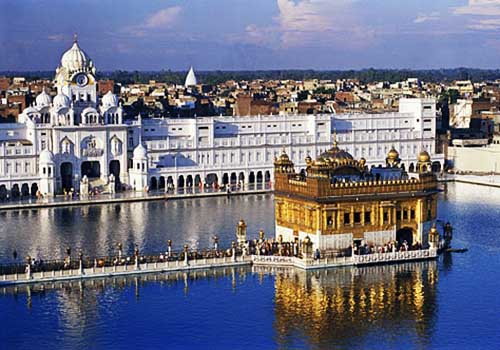 Sikh Guru, Guru Amar Das, in the neighbouring town of Goindval, was so impressed by the way of life in the town that he gave a jagir (the land and the revenues of several villages in the vicinity) to the Guru’s daughter Bhani as a gift on her marriage to Bhai Jetha, who later became the fourth Sikh Guru, Guru Ram Das ji. Guru Ram Das ji enlarged the lake and built a small township around it. The town was named after Guru Ram Das ji as Guru Ka Chak’, Chak Ram Das or Ram Das Pura.
Sikh Guru, Guru Amar Das, in the neighbouring town of Goindval, was so impressed by the way of life in the town that he gave a jagir (the land and the revenues of several villages in the vicinity) to the Guru’s daughter Bhani as a gift on her marriage to Bhai Jetha, who later became the fourth Sikh Guru, Guru Ram Das ji. Guru Ram Das ji enlarged the lake and built a small township around it. The town was named after Guru Ram Das ji as Guru Ka Chak’, Chak Ram Das or Ram Das Pura.
During the leadership of the fifth Guru, Guru Arjan Dev (1581–1606), the full-fledged Gurdwara was built. In December 1588, Guru Arjan Dev ji initiated the construction of the Gurdwara. The foundation stone was laid by none other than Sri Guru Arjan Dev Sahib himself in December 1588. It is a common misconception that the foundation stone was laid by the Sufi saint Mian Mir of Lahore.
Some of the architectural features of Golden Temple (Darbar Sahib) were intended to be symbolic of the Sikh worldview. Instead of the normal custom of building a Gurdwara on high land, it was built at a lower level than the surrounding land so that devotees would have to go down steps to enter it. In addition, instead of one entrance, Golden Temple (Darbar Sahib) has four entrances.
The Gurdwara was completed in 1604. Guru Arjan Dev ji, installed the Guru Granth Sahib in it and appointed Baba Buddha Ji as the first Granthi (reader) of it on August 1604. In the mid-18th century it was attacked by the Afghans, by one of Ahmed Shah Abdali’s generals, Jahan Khan, and had to be substantially rebuilt in the 1760s. However, in response a Sikh Army was sent to hunt down the Afghan force. Both forces met each other five miles outside Amritsar; Jahan Khan’s army was destroyed.
The Gurdwara is surrounded by a large lake or holy tank, known as the Sarovar, which consists of Amrit (“holy water” or “immortal nectar”). There are four entrances to the Gurdwara, signifying the importance of acceptance and openness. Inside the Gurdwara complex there are many shrines to past Sikh Gurus, saints and martyrs (see map). There are three holy trees (bers), each signifying a historical event or Sikh saint. Inside the Gurdwara there are many memorial plaques that commemorate past Sikh historical events, saints, martyrs and includes commemorative inscriptions of all the Sikh soldiers who died fighting in World Wars I and II.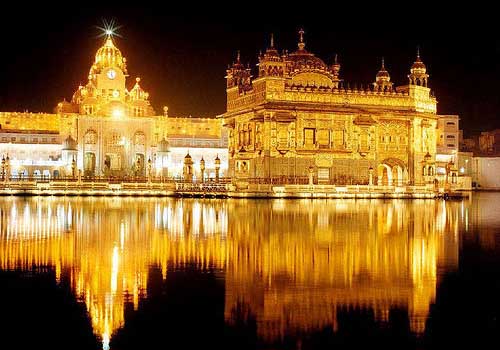 In 1988, after Operation Black Thunder, the government acquired a narrow peripheral strip of land (including buildings) in order to use their space as a security buffer. The acquisition process involved the displacement and relocation of a large number of residences and businesses. However, the project met with a strong resistance from both moderate and militant Sikh organisations and had to be abandoned following the murder of a senior government-employed engineer connected with the project. The project was revived only in 1993 by the Deputy Commissioner Karan Bir Singh Sidhu, who was also appointed as the project director of what became popularly known as the Galliara Project. He changed the concept of the periphery from that of a security belt to that of a second parikarma and created a serene landscape that was fully consistent with the ethereal beauty of Golden Temple (Darbar Sahib). This was done in quiet consultation with the Shiromani Gurdwara Prabandhak Committee (SGPC). Present-day pilgrims can travel by foot in the Galliara; no vehicles are permitted.
In 1988, after Operation Black Thunder, the government acquired a narrow peripheral strip of land (including buildings) in order to use their space as a security buffer. The acquisition process involved the displacement and relocation of a large number of residences and businesses. However, the project met with a strong resistance from both moderate and militant Sikh organisations and had to be abandoned following the murder of a senior government-employed engineer connected with the project. The project was revived only in 1993 by the Deputy Commissioner Karan Bir Singh Sidhu, who was also appointed as the project director of what became popularly known as the Galliara Project. He changed the concept of the periphery from that of a security belt to that of a second parikarma and created a serene landscape that was fully consistent with the ethereal beauty of Golden Temple (Darbar Sahib). This was done in quiet consultation with the Shiromani Gurdwara Prabandhak Committee (SGPC). Present-day pilgrims can travel by foot in the Galliara; no vehicles are permitted.
In keeping with the rule observed at all Sikh Gurdwaras worldwide, Golden Temple (Darbar Sahib) is open to all persons regardless of their religion, colour, creed, or sex. The only restrictions on Golden Temple (Darbar Sahib)’s visitors concern their behavior when entering and while visiting:
Maintaining the purity of the sacred space and of one’s body while in it:. Upon entering the premises, removing one’s shoes (leaving them off for the duration of one’s visit) and washing one’s feet in the small pool of water provided; Not drinking alcohol, eating meat, or smoking cigarettes or other drugs while in the shrine. Wearing a head covering (a sign of respect) (the Gurdwara provides head scarves for visitors who have not brought a suitable covering). One must also sit on the ground while in the Darbar Sahib as a sign of deference to both the Sri Guru Granth Sahib and God. First-time visitors are advised to begin their visit at the information office highlighted in the map and then proceed to the Central Sikh Museum near the main entrance and clock tower.
Much of the present decorative gilding and marblework dates from the early 19th century. All the gold and exquisite marble work were conducted under the patronage of Hukam Singh Chimni and Emperor Ranjit Singh, Maharaja of the Sikh Empire of the Punjab. The Darshani Deorhi Arch stands at the beginning of the causeway to Golden Temple (Darbar Sahib); it is 202 feet (62 m) high and 21 feet (6 m) in width. The gold plating on the Golden Temple (Darbar Sahib) was begun by Emperor Ranjit Singh and was finished in 1830. The Sher-e-Punjab (Lion of the Punjab) was a major donor of wealth and materials for the shrine and is remembered with much affection by the Punjabi people in general and the Sikh community in particular. Maharaja Ranjit Singh also built two of the other most sacred Gurdwaras in Sikhism. This was because Maharaja Ranjit Singh had a deep love for the tenth guru of Sikhism Guru Gobind Singh. The other two most sacred Gurdwaras in Sikhism, which he built, are Takht Sri Patna Sahib (initiation or birth place of Guru Gobind Singh ji) and Takht Sri Hazur Sahib, the place of Guru Gobind Singh ji’s Sikh ascension into heaven.
One of the most important festivals is Vaisakhi, which is celebrated in the second week of April (usually the 13th). Sikhs celebrate the founding of the Khalsa on this day and it is celebrated with fervour in Golden Temple (Darbar Sahib). Other important Sikh religious days such as the martyrdom day of Guru Teg Bahadur, the birthday of Guru Nanak Dev, etc., are also celebrated with religious piety. Similarly Diwali is one of the festivals which sees Golden Temple (Darbar Sahib) beautifully illuminated with Divas/Diyas (lamps); lights and fireworks are discharged. During these special occasions many thousands of people visit the holy shrine named Golden Temple (Darbar Sahib). Most Sikh people visit Amritsar and Golden Temple (Darbar Sahib) at least once during their lifetime, particularly and mostly during special occasions in their life such as birthdays, marriages, childbirth, etc.
Operation Blue Star was commenced on 3 June 1984 and ended on 6 June 1984. The Indian Army led by General Kuldip Singh Brar brought infantry, artillery, and tanks into Golden Temple (Darbar Sahib) to arrest Jarnail Singh Bhindranwale. Golden Temple (Darbar Sahib) complex and some of the surrounding houses were fortified. The Statesman reported on 4 July that light machine-guns and sophisticated self-loading rifles were known to have been brought into the compound.
Indira Gandhi ordered the army to launch Operation Blue Star. Within six months, Indira Gandhi’s Sikh bodyguards killed her (31 October 1984) for the perceived sacrilege.
Fierce fighting ensued between Bhindranwale’s supporters and the soldiers, in which many of Bhindranwale’s supporters were killed along with many soldiers. An official account tallies the deaths of 83 soldiers and 492 civilians killed by the army Golden Temple (Darbar Sahib) complex also suffered much damage due to the fighting, especially the holy Sri Akal Takhat Sahib.
Many Sikhs regarded the attack as a desecration of their holiest shrine and discrimination of a minority.
In 1986, the repairs performed on the holy Sri Akal Takhat Sahib, which the Rajiv Gandhi Government had undertaken without consultation, were removed. A new Sri Akal Takhat Sahib was completed in 1999 by Kar Sevaks.
